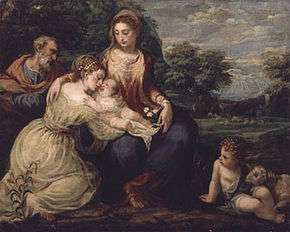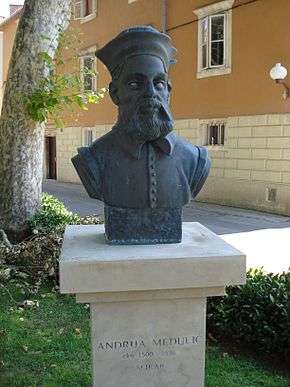Andrea Schiavone


Andrea Meldolla (Croatian: Andrija Medulić), also known as Andrea Schiavone or Andrea Lo Schiavone (c. 1510/1515–1563) was an Italian[1] Renaissance painter and etcher, born in present-day Croatia, active mainly in the city of Venice.
Biography
Meldolla was born in the Venetian-ruled city of Zara in Dalmatia, now Zadar in Croatia,[2] the son of a garrison commander of a post nearby. His family was originally from the small town of Meldola, close to the city of Forlì in Romagna.
He trained either in Zara or in Venice. Lomazzo stated, in a book of 1584, that he was a pupil of Parmigianino, but this has been doubted. There are unproven claims that he trained with Bonifazio de Pitati. He worked in fresco, panel painting, and etching (teaching himself to etch by working initially from drawings by Parmigianino). By 1540, he was well enough established in Venice that Giorgio Vasari commissioned him a large battle picture (which the Florentine author mentions in his Lives). Although initially much influenced by Parmigianino and Italian Mannerism, "he was also a strikingly daring exponent of Venetian painting techniques", and ultimately combined both in his works, influencing Titian, Tintoretto, and Jacopo Bassano among others. His works "shocked some contemporaries and stimulated others". By the 1550s, he had achieved a new synthesis of Raphael and Titian's compositional elements with his own interest in atmosphere, effecting a "fusion of form with a dense atmosphere in a pictorial fabric whose elements tend to lose their separate indenties".
In Painting in Italy, 1500-1600, Freedberg describes Meldolla as well adapted to the Mannerist vocabulary, and that while he was "able to invent a Venetian Maniera...he was strangely uncreative in the more ordinary workings of artistic invention." Later in the 1550s, "occasionally, the sensibility - too receptive, almost feminine - that inclined Schiavone towards imitation brought him to the verge of echo of the larger personality (Titian)". Other works have attributions disputed between him and Tintoretto. Few of his paintings are documented; this may be because, as Vasari states, he mostly worked for private clients.
Richardson also insists on his importance as an etcher: "In etching he was similarly innovative. His technique was unlike that of any contemporary: unsystematically he used dense webs of light, fine, multidirectional hatching to create a tonal continuum embracing form, light, shadow, and air. His etchings are the only real equivalent in printmaking of later 16th-century Venetian painting modes, and his technical experiments were emulated by 17th-century etchers such as Jacques Bellange, Giovanni Benedetto Castiglione and Rembrandt".
Meldolla died in Venice.
References
- Freedberg, Sydney J. (1993). Pelican History of Art, ed. Painting in Italy, 1500-1600. Penguin Books. pp. 533–534.
- Richardson, Francis E. (1980). Andrea Schiavone. Oxford and New York: Oxford University Press.
- Richardson, Francis E. the Encyclopedia of Italian Renaissance & Mannerist Art. pp. 1502–04 at 1503.
Notes
- ↑ "Schiavone, Andrea." The Oxford Dictionary of Art. Web. 27 Apr. 2011.
- ↑ Because of his birthplace, Lo Schiavone appears in Croatian literature and history of art exclusively as Andrija Medulić, which is the Croatian version of his name. His Italian nickname, Schiavone, meant "Slav" in Old Italian - the ethnonym Schiavone usually indicated origins in parts of Croatia (Dalmatia or Istria) under the rule of the Republic of Venice.
Further Reading
- Zeri, F. & Gardner, E. (1973). Italian Paintings: A Catalogue of the Collection of The Metropolitan Museum of Art, Venetian School. New York: The Metropolitan Museum of Art. ISBN 0-87099-079-9. (see index; plates 56-57)
External links
| Wikimedia Commons has media related to Andrea Schiavone (Andrea Meldolla). |
| Wikisource has the text of a 1920 Encyclopedia Americana article about Andrea Schiavone. |
- Birmingham Museum & Art Gallery - Biography of Andrea Schiavone
- Andrea Schiavone, The J. Paul Getty Museum
- Giorgio Vasari's Lives of the Artists
|

